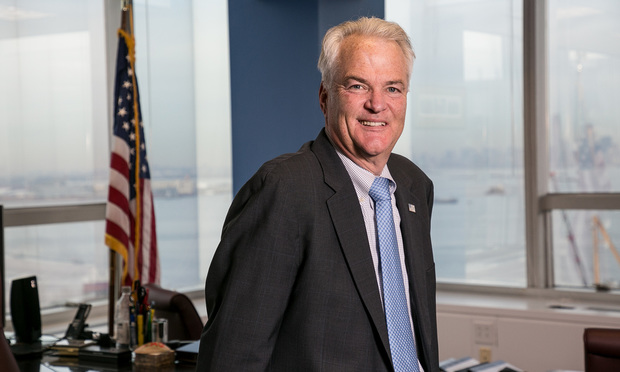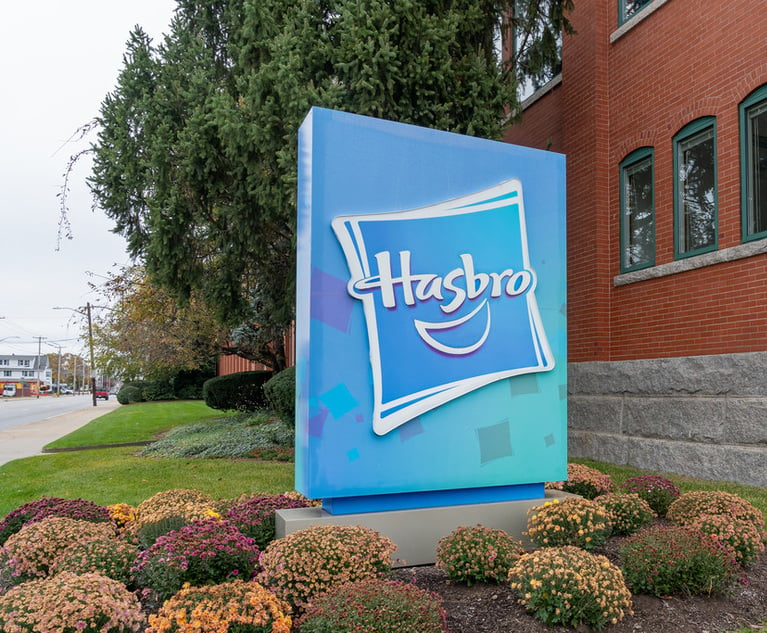Critics Say Staten Island DA's Diversion Program for Opioid Addicts, a Model for NYC, Is Falling Short
The Staten Island district attorney's groundbreaking diversionary program for opioid addicts is falling short in terms of combating the opioid epidemic because it excludes defendants with certain prior convictions, say drug law reform advocates and public defenders.
June 25, 2018 at 05:25 PM
5 minute read
 Staten Island DA Michael McMahon. Photo: Carmen Natale/ALM The Staten Island district attorney's groundbreaking diversionary program for opioid addicts is falling short in terms of combating the opioid epidemic because it excludes defendants with certain prior convictions, say drug law reform advocates and public defenders. Critics have raised their concerns about Staten Island's Heroin Overdose Prevention and Education program, which was unveiled in February 2017, as district attorney's offices in other boroughs are getting their own programs off the ground—Bronx justice system officials announced the Overdose Avoidance and Recovery program in December and Brooklyn District Attorney Eric Gonzalez announced the launch of the Collaborative Legal Engagement Assistance Response program in March. According to statistics from the office of Staten Island District Attorney Michael McMahon, 468 defendants who faced low-level drug charges have been referred to HOPE, of which 361 completed the program and had their charges withdrawn. About 5 percent of referrals have had their cases turned away, according to his office's count. But because it excludes defendants with felonies on their records, for every one defendant referred to the program, two are barred from entry, said Melissa Moore, deputy state director of the New York office for the Drug Policy Alliance. Additionally, she said, McMahon's office has taken a heavy-handed approach to prosecuting pushers, which potentially prevents them from receiving effective treatment if they are addicts themselves. Moore said McMahon is taking a “war on drugs” approach to the issue rather than fully embracing a rehabilitative approach and that, because people with past criminal histories tend to disproportionately come from communities of color, may provide wider access to white defendants. “The door really should be open to everybody who needs care,” Moore said. While the diversionary program in the Bronx has been in operation for several months, Moore said there isn't enough data available at this point to determine if some of the issues occurring in Staten Island are happening in the Bronx as well. But McMahon said there are drug courts available for defendants who are excluded from HOPE and defended his approach to the opioid crisis in his jurisdiction, which he said is a public health issue in addition to a public safety issue. “We have to be clear that people who are dealing, and if they deal death, then they will be prosecuted,” McMahon said. “This is a public health and a public safety issue. And if someone is selling illegal drugs, dangerous illegal drugs like fentanyl, and it is known who they are selling to then I'm going to lob a very punitive sentence at them. You can be damned sure of that.” McMahon's office was the first in the city to prosecute a dealer who sold a lethal dose on a manslaughter charge. Last year, his office brought second-degree manslaughter and criminally-negligent homicide charges against Stephen Cummings for selling fentanyl-laced heroin from a Staten Island barber shop that killed a 52-year-old man. Cummings' case is pending. His lawyer, Mario Gallucci of Helbock, Nappa & Gallucci, said Cummings has pleaded not guilty and that he has filed a motion to dismiss the indictment, arguing that the DA has not presented evidence to a grand jury that Cummings' wares caused the victim's death. "Just because my client bragged about his quality could be chalked up to 'mere puffery,'" Gallucci said. The judge in Cummings' case has yet to rule on the motion.
Staten Island DA Michael McMahon. Photo: Carmen Natale/ALM The Staten Island district attorney's groundbreaking diversionary program for opioid addicts is falling short in terms of combating the opioid epidemic because it excludes defendants with certain prior convictions, say drug law reform advocates and public defenders. Critics have raised their concerns about Staten Island's Heroin Overdose Prevention and Education program, which was unveiled in February 2017, as district attorney's offices in other boroughs are getting their own programs off the ground—Bronx justice system officials announced the Overdose Avoidance and Recovery program in December and Brooklyn District Attorney Eric Gonzalez announced the launch of the Collaborative Legal Engagement Assistance Response program in March. According to statistics from the office of Staten Island District Attorney Michael McMahon, 468 defendants who faced low-level drug charges have been referred to HOPE, of which 361 completed the program and had their charges withdrawn. About 5 percent of referrals have had their cases turned away, according to his office's count. But because it excludes defendants with felonies on their records, for every one defendant referred to the program, two are barred from entry, said Melissa Moore, deputy state director of the New York office for the Drug Policy Alliance. Additionally, she said, McMahon's office has taken a heavy-handed approach to prosecuting pushers, which potentially prevents them from receiving effective treatment if they are addicts themselves. Moore said McMahon is taking a “war on drugs” approach to the issue rather than fully embracing a rehabilitative approach and that, because people with past criminal histories tend to disproportionately come from communities of color, may provide wider access to white defendants. “The door really should be open to everybody who needs care,” Moore said. While the diversionary program in the Bronx has been in operation for several months, Moore said there isn't enough data available at this point to determine if some of the issues occurring in Staten Island are happening in the Bronx as well. But McMahon said there are drug courts available for defendants who are excluded from HOPE and defended his approach to the opioid crisis in his jurisdiction, which he said is a public health issue in addition to a public safety issue. “We have to be clear that people who are dealing, and if they deal death, then they will be prosecuted,” McMahon said. “This is a public health and a public safety issue. And if someone is selling illegal drugs, dangerous illegal drugs like fentanyl, and it is known who they are selling to then I'm going to lob a very punitive sentence at them. You can be damned sure of that.” McMahon's office was the first in the city to prosecute a dealer who sold a lethal dose on a manslaughter charge. Last year, his office brought second-degree manslaughter and criminally-negligent homicide charges against Stephen Cummings for selling fentanyl-laced heroin from a Staten Island barber shop that killed a 52-year-old man. Cummings' case is pending. His lawyer, Mario Gallucci of Helbock, Nappa & Gallucci, said Cummings has pleaded not guilty and that he has filed a motion to dismiss the indictment, arguing that the DA has not presented evidence to a grand jury that Cummings' wares caused the victim's death. "Just because my client bragged about his quality could be chalked up to 'mere puffery,'" Gallucci said. The judge in Cummings' case has yet to rule on the motion. Christopher Pisciotta, the attorney-in-charge of the Legal Aid Society's criminal defense practice on Staten Island, said that in his judgment HOPE has proven to be effective and that McMahon expressed a willingness to expand HOPE when the program was launched to include more defendants, but that since then no further steps have been taken to grow eligibility.
Pisciotta said HOPE could be expanded by including defendants who have warrants or those who face charges that aren't directly related to narcotics but associated with criminal behavior driven by addiction, such as theft, shoplifting or trespassing.
“If you address the substance abuse, you could address the criminal behavior,” Pisciotta said.
According to a report from the Office of Court Administration, the number of referrals to the Staten Island Treatment Court, which accepts persistent misdemeanor and first-time felony offenders, fell from 434 in 2014 to 201 in 2016.
This content has been archived. It is available through our partners, LexisNexis® and Bloomberg Law.
To view this content, please continue to their sites.
Not a Lexis Subscriber?
Subscribe Now
Not a Bloomberg Law Subscriber?
Subscribe Now
NOT FOR REPRINT
© 2025 ALM Global, LLC, All Rights Reserved. Request academic re-use from www.copyright.com. All other uses, submit a request to [email protected]. For more information visit Asset & Logo Licensing.
You Might Like
View All
Justice 'Weaponization Working Group' Will Examine Officials Who Investigated Trump, US AG Bondi Says

Lawyers Across Political Spectrum Launch Public Interest Team to Litigate Against Antisemitism
4 minute read
'Landmark' New York Commission Set to Study Overburdened, Under-Resourced Family Courts

Trending Stories
- 1States Accuse Trump of Thwarting Court's Funding Restoration Order
- 2Microsoft Becomes Latest Tech Company to Face Claims of Stealing Marketing Commissions From Influencers
- 3Coral Gables Attorney Busted for Stalking Lawyer
- 4Trump's DOJ Delays Releasing Jan. 6 FBI Agents List Under Consent Order
- 5Securities Report Says That 2024 Settlements Passed a Total of $5.2B
Who Got The Work
J. Brugh Lower of Gibbons has entered an appearance for industrial equipment supplier Devco Corporation in a pending trademark infringement lawsuit. The suit, accusing the defendant of selling knock-off Graco products, was filed Dec. 18 in New Jersey District Court by Rivkin Radler on behalf of Graco Inc. and Graco Minnesota. The case, assigned to U.S. District Judge Zahid N. Quraishi, is 3:24-cv-11294, Graco Inc. et al v. Devco Corporation.
Who Got The Work
Rebecca Maller-Stein and Kent A. Yalowitz of Arnold & Porter Kaye Scholer have entered their appearances for Hanaco Venture Capital and its executives, Lior Prosor and David Frankel, in a pending securities lawsuit. The action, filed on Dec. 24 in New York Southern District Court by Zell, Aron & Co. on behalf of Goldeneye Advisors, accuses the defendants of negligently and fraudulently managing the plaintiff's $1 million investment. The case, assigned to U.S. District Judge Vernon S. Broderick, is 1:24-cv-09918, Goldeneye Advisors, LLC v. Hanaco Venture Capital, Ltd. et al.
Who Got The Work
Attorneys from A&O Shearman has stepped in as defense counsel for Toronto-Dominion Bank and other defendants in a pending securities class action. The suit, filed Dec. 11 in New York Southern District Court by Bleichmar Fonti & Auld, accuses the defendants of concealing the bank's 'pervasive' deficiencies in regards to its compliance with the Bank Secrecy Act and the quality of its anti-money laundering controls. The case, assigned to U.S. District Judge Arun Subramanian, is 1:24-cv-09445, Gonzalez v. The Toronto-Dominion Bank et al.
Who Got The Work
Crown Castle International, a Pennsylvania company providing shared communications infrastructure, has turned to Luke D. Wolf of Gordon Rees Scully Mansukhani to fend off a pending breach-of-contract lawsuit. The court action, filed Nov. 25 in Michigan Eastern District Court by Hooper Hathaway PC on behalf of The Town Residences LLC, accuses Crown Castle of failing to transfer approximately $30,000 in utility payments from T-Mobile in breach of a roof-top lease and assignment agreement. The case, assigned to U.S. District Judge Susan K. Declercq, is 2:24-cv-13131, The Town Residences LLC v. T-Mobile US, Inc. et al.
Who Got The Work
Wilfred P. Coronato and Daniel M. Schwartz of McCarter & English have stepped in as defense counsel to Electrolux Home Products Inc. in a pending product liability lawsuit. The court action, filed Nov. 26 in New York Eastern District Court by Poulos Lopiccolo PC and Nagel Rice LLP on behalf of David Stern, alleges that the defendant's refrigerators’ drawers and shelving repeatedly break and fall apart within months after purchase. The case, assigned to U.S. District Judge Joan M. Azrack, is 2:24-cv-08204, Stern v. Electrolux Home Products, Inc.
Featured Firms
Law Offices of Gary Martin Hays & Associates, P.C.
(470) 294-1674
Law Offices of Mark E. Salomone
(857) 444-6468
Smith & Hassler
(713) 739-1250






